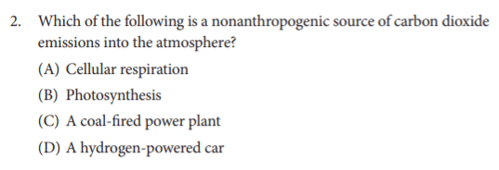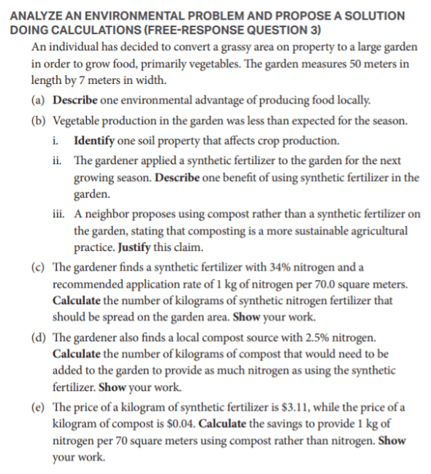
Knowing how to review for an AP exam can be challenging. Based on average exam scores, it appears that many students who take AP Environmental Science don't adequately prepare for the final test.
Fortunately, if you're not sure where to start, this guide will walk you through the complete AP Environmental Science review process. We'll start by going over the format of the AP exam and what it covers, including sample questions. We'll then move on to helpful review strategies and the plan you should follow to prep for the exam.
What's the Format of the AP Environmental Science Exam?
The AP Environmental Science exam changed significantly in 2020, so it's important that you know whether your review materials are up-to-date or not.
The new test is two hours and 40 minutes long and contains 80 multiple-choice questions and three free-response questions. (Previously, the test lasted three hours and included 100 multiple-choice questions and four free-response questions.) In addition, you are allowed to use a graphing calculator throughout the entire exam.
You can learn more about these major changes to the exam in the new APES Course Description.
Here's a quick overview of the new AP Enviro exam format:
| AP Enviro Section | Time | # of Questions | % of Score |
| Section 1: Multiple Choice | 1 hr 30 mins | 80 | 60% |
| Section 2: Free Response | 1 hr 10 mins | 3 | 40% |
| TOTAL | 2 hrs 40 mins | 83 | 100% |
As you can see, the multiple-choice section, which comes first, is worth 60% of your final AP score and consists of 80 questions in 90 minutes; this means you'll have a little more than a minute per question. There are no penalties for wrong answers, so be sure to always put something down!
Each multiple-choice question comes with four answer choices, labeled A-D. (Before, the APES exam had five answer choices for each question.) You'll get both stand-alone questions and questions in sets. In total, you can expect three to four sets on quantitative data (charts, graphs, etc.), three to four sets on qualitative data (maps, models, etc.), and five questions on a passage or text.
The free-response section counts for 40% of your total AP score. You'll need to answer three free-response questions. Each of them is worth 10 raw points, or about 13.3% of your final score. Since you will get 70 minutes for this section, this means you'll have around 23 minutes per question.
The three free-response question types will remain consistent from year to year:
- Question 1: Design an investigation
- Question 2: Analyze an environmental problem and propose a solution
- Question 3: Analyze an environmental problem and propose a solution by doing calculations
What Does the AP Environmental Science Exam Cover?
Before we get into the nitty-gritty of APES review, it'll help to broadly go over what the exam covers to help put everything in context. Environmental science is a multi-disciplinary topic that looks at concepts from science, history, current events, and more.
In this section, we'll be taking a closer look at the major themes and topics on the exam.
AP Environmental Science Big Ideas
The test will touch on many areas, but there are four main themes, or "Big Ideas," as the College Board calls them, it seeks to focus on. Every question you see on the exam will relate back to at least one of these ideas, so they're helpful to keep in mind as you navigate your AP review process.
Here is how each Big Idea is described in the AP Enviro Course and Exam Description.
Big Idea 1: Energy Transfer
Energy conversions underlie all ecological processes. Energy cannot be created; it must come from somewhere. As energy flows through systems, at each step, more of it becomes unusable.
Big Idea 2: Interactions Between Earth Systems
The Earth is one interconnected system. Natural systems change over time and space. Biogeochemical systems vary in ability to recover from disturbances.
Big Idea 3: Interactions Between Different Species and the Environment
Humans alter natural systems and have had an impact on the environment for millions of years. Technology and population growth have enabled humans to increase both the rate and scale of their impact on the environment.
Big Idea 4: Sustainability
Human survival depends on developing practices that will achieve sustainable systems. A suitable combination of conservation and development is required. The management of resources is essential. Understanding the role of cultural, social, and economic factors is vital to the development of solutions.

AP Environmental Science Units
AP Environmental Science also has nine units, which make up the content in the course and on the final exam. These major topics are more specific than the above themes, and knowing them will help give you a better idea of what exactly will be covered on the exam.
Each unit contains several smaller topics. We've included a few examples of these for each major unit below. For the complete list of topics, refer to page 20 of the Course and Exam Description.
| AP Environmental Science Unit | Sample Topics | % of Exam Questions |
| Unit 1: The Living World: Ecosystems | Biomes, carbon cycle, trophic levels, food chains | 6-8% |
| Unit 2: The Living World: Biodiversity | Biogeography, ecological tolerance, adaptations | 6-8% |
| Unit 3: Populations | Types of species, population growth, fertility rate | 10-15% |
| Unit 4: Earth Systems and Resources | Plate tectonics, climate, soil composition, atmosphere | 10-15% |
| Unit 5: Land and Water Use | Irrigation, pest control, meat production, sustainability | 10-15% |
| Unit 6: Energy Resources and Consumption | Renewable resources, fossil fuels, solar and wind energy | 10-15% |
| Unit 7: Atmospheric Pollution | Air pollution, smog, noise pollution, acid rain | 7-10% |
| Unit 8: Aquatic and Terrestrial Pollution | Human impacts, waste reduction, sewage treatment | 7-10% |
| Unit 9: Global Change | Greenhouse effect, climate change, invasive species | 15-20% |
What Do Questions Look Like on the AP Enviro Exam?
There are two sections on the AP Environmental Science exam: Multiple Choice and Free Response. Official sample problems from both sections are shown below. Samples come from the 2019-20 AP Enviro Course and Exam Description.
Multiple-Choice Sample Question

To answer this multiple-choice question, you msut know what the term "nonanthropogenic" means. Let's think of it in terms of the original term "anthropogenic," which refers to things (often problems with pollution) related to or caused by human activity; therefore, "nonanthropogenic" is things that are not caused by humans but rather by natural processes.
This leaves us with two possible answer choices: A or B (C and D are both human contributors to pollution in the atmosphere, meaning they are anthropogenic). Photosynthesis, or choice B, doesn't make any sense because in this process, plants transform carbon dioxide into oxygen, not the other way around.
With cellular respiration, or choice A, animals breathe in oxygen and create carbon dioxide, so the correct answer must be A.
Other multiple-choice APES questions may refer to a graph or text, require calculations, or be part of a set of related questions. Later in this guide, I'll go over where you can find more multiple-choice practice questions and how to use them in your AP Enviro prep.
Free-Response Sample Question

Every free-response question on AP Enviro is worth 10 raw points. Here, you must propose a solution to an environmental problem using mathematical calculations (remember, you'll have access to a graphing calculator).
You can earn up to 1 point for (a), 3 points for (b), and 2 points each for (c), (d), and (e).
To see complete answers to this question and other APES free-response questions, check out our dedicated guide to the AP Environmental Science Free-Response Section.

How to Review for AP Environmental Science: 7-Step Guide
In this section, we'll walk you through each step you should take during your AP Environmental Science review. Follow these seven steps, be thoughtful about your weaknesses and progress, and you'll be on your way to success!
How long will it take to review for the AP Environmental Science AP exam? That'll vary for everyone, but below are some estimates of how long you should spend on specific steps:
- Take and grade your first practice test: 3.5 hours
- Analyze your mistakes: 1 hour
- Review your weak areas and revise test strategies: 3 hours
- Take and grade another practice test: 3.5 hours
So, going through one cycle of these steps will take you around 11 hours. Remember that you might want to repeat this entire cycle to really get the information to sink in.
Now then, let's take a look at the seven-step AP Environmental Science review you should follow!
Step 1: Get Your Review Materials Ready
Before you begin reviewing, make sure you have all the materials you'll need ready and organized. It's best to start this step around the end of fall, but even if you're just starting a few weeks before the exam, never fear! A handful of weeks of dedicated studying can be enough to help you score well on the APES test.
So what materials do you need? Many people find it helpful to purchase a review book. Unlike your textbook, review books focus specifically on the information you will need to know for the AP exam, so you're not wading through extraneous info you don't need to worry about.
Before getting an AP Enviro review book, it's a good idea to read reviews online or ask your classmates if they have a book they'd recommend. In general, books by The Princeton Review and Barron's are solid choices.
Don't neglect your class materials, though! Your notes and textbook can be extremely useful for in-depth review of specific topics you want to brush up on.
Finally, practice tests are one of the most important ways to review for the APES test, so you want to make sure you've gathered as many of them as possible. You can check out our collection of AP Environmental Science practice tests or use the following links for quick access:
- The 1998 AP Enviro practice exam is the only free official APES practice test
- For free-response questions, there are lots of official examples from previous AP exams
- For multiple-choice questions, there are 15 examples in the 2019-20 APES Course Description
- For unofficial practice, Varsity Tutors offers a solid 100-question multiple-choice APES test
Step 2: Take and Score a Practice Test
The next step is to take a complete practice test under realistic testing conditions (90 minutes for multiple choice and 70 minutes for FRQs, all taken in one sitting). We recommend combining the Varsity Tutors multiple-choice test with a set of official FRQs and saving the free full-length official practice test from 1998 for later on in your prep.
After you take the test, score it to see how well you did. For your FRQs, use the official (and fully updated) scoring guidelines. Note that many unofficial resources are automatically scored, but if you need help estimating your final AP score on a scale of 1-5, you can use this AP score calculator.
Step 3: Set a Score Target
Now that you know how well you're currently scoring on the APES exam, you can set a score target. Despite its low score averages, AP Environmental Science is generally considered one of the less challenging AP exams, so most students who are able to commit some time to studying should aim for a 4 or a 5. However, if you're currently scoring a 2 or lower or know that you won't be able to study much, you might want to aim for a 3 instead.

Step 4: Analyze Your Mistakes
You now know what score you're aiming for and how far you are from it; this means that it's time to start analyzing which questions you got wrong and why.
Go through the APES practice test you took and look over every question you got wrong. Think about why you got it wrong and look for patterns. Did you miss a lot of questions that involved calculations? Did you know global change but got most questions on energy resources incorrect?
This might feel like a long and tiresome step, but don't be tempted to skip it. It'll save you time in the long run, and it's really the only way to improve your AP score significantly.
Step 5: Review Your Weak Content Areas
Next, use the information you got from going over your practice exam and focus particularly on improving each of your weak areas. If there are certain topics or types of questions that gave you significant trouble, review your notes and do practice questions until you feel more confident with them.
Don't just passively read through your notes—actively engage with them. Underline important words and phrases, rewrite key points in your own words, and regularly stop and go over in your head what you just learned to make sure you're actually retaining the information.
Step 6: Revise Your Test-Taking Strategies
A lot of the time, it's not just the content of the AP test that's challenging but also how much you're expected to do in just two hours and 40 minutes that can cause you to make mistakes. If you find yourself either running out of time or making careless errors, you likely need to make some changes to how quickly or how slowly you move through the exam.
If you often run out of time, then spend future practice tests timing yourself more carefully. For the multiple-choice section, you'll have 90 minutes to answer 80 questions; that's 67.5 seconds per question. Getting stuck on just one question can prevent you from answering multiple other questions, which can really hurt your score.
If you've looked at a question for 90 seconds and still have no idea how to answer it, skip it and come back to it at the end if you have time remaining. (Remember to answer every question, though, by the time the section ends, even if it's a random guess; there are no point deductions for incorrect answers, so don't leave any questions blank!)
For the free-response section, you'll have about 23 minutes to answer each question; however, no one will force you to move on to the next question, so it can be easy to lose track of time. Taking practice free-response sections and carefully timing yourself can help with this issue.
Also, if you find yourself making numerous careless errors on the exam, try to slow down a bit and read each question twice before you begin answering it.
For both sections of the AP Environmental Science test, answering practice questions regularly can help you get a handle on timing issues and become more used to how long you will have to answer each question.
Step 7: Take Another Practice Test
After all your hard work, it's time to take another complete practice test to see how much you've improved. Follow the same rules as for your first practice test and figure out your score. If you've improved a lot and are close to your score target, you might only need to do light studying up until the APES exam in May.
If you've improved but still aren't exactly where you want to be, repeat the above steps again to continue working on your weaknesses.
If, however, you haven't improved a lot or are still far from your target score, you'll have to change up your methods. Examine how you've been reviewing the material and which questions you're getting wrong. Maybe you weren't paying close enough attention or were passively reading through your notes instead of actively engaging with them.
Make a list of things you'll change (such as studying more actively, paying even closer attention to your notes, etc.) and implement those changes as you go through these steps again.
Wrap-Up: Key Tips for Your AP Environmental Science Review
Being well prepared and ready for the AP Environmental Science exam will give you a much better shot at doing well on the test. Make sure you know all about the new 2020 exam format and what material it covers before you begin your review.
Your AP Environmental Science review process should include the following steps:
Step 1: Gather review materials
Step 2: Take and grade an initial practice test
Step 3: Set a score target
Step 4: Analyze your mistakes
Step 5: Review weak content areas
Step 6: Revise test strategies
Step 7: Take and grade another practice test to see how you've improved
Remember that it's OK to repeat this cycle as many times as you need to so you can ultimately reach your goal score on test day!

What's Next?
Want some more practice materials for the AP Environmental Science Exam? We've got you covered with our huge collection of free and official APES practice quizzes and tests.
Need some help reviewing for your other AP classes? Learn the five study tips and strategies you should use for all AP exams.
Are you self-studying for AP Environmental Science or another AP exam? Learn the seven steps you should be following when self-studying in order to maximize your chances of getting a great AP score.
Have friends who also need help with test prep? Share this article!

Christine graduated from Michigan State University with degrees in Environmental Biology and Geography and received her Master's from Duke University. In high school she scored in the 99th percentile on the SAT and was named a National Merit Finalist. She has taught English and biology in several countries.



































 Holly R.
Holly R.